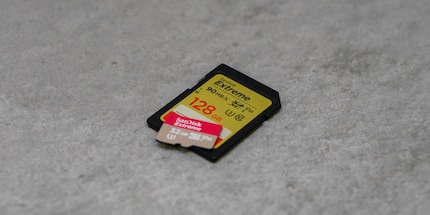
Background information
SSD operation is a complex business
by Kevin Hofer

SD cards can be found in devices such as cameras and smartphones. Over the years, several SD standards have been added, causing confusion. How have they evolved and what should you look out for when making a purchase?
SD cards are something emotionless. At least as long as they work. That's why I was anything but jumping for joy when we in the team decided to make an SD card guide. I don't know exactly what I ate the night before, but I agreed to do it. Bollocks. That's what I get for not being able to say no.
Okay, since I actually find the topic very dry, I'll spice it up with some history. If someone had told me in 6th grade that I would claim to make something more interesting with history, I would have laughed at them. If you're just looking for information about the hieroglyphs on the cards or want to know which card is suitable for which purpose, it's best to skip this part. Below you will find tables and buying advice.
The beginnings
The Secure Digital card was developed in 1999 by Panasonic, Toshiba and Sandisk. The technology is based on the Multi Media Card (MMC) released by Sandisk and Siemens two years earlier. Incidentally, the "Secure" in SD refers to the ability to store encrypted media files. However, this feature is hardly used today. In addition to SD cards, micro SD cards have been available since 2005. These are much smaller and are mainly used in smartphones. There was also once a mini SD card. However, this is now extinct due to a lack of use and competition from the micro SD card.

SD cards have built-in flash memory. This is characterised by its non-volatility and reusability. It was developed by Toshiba in the early 1980s. Data can be stored on flash memory for up to ten years without connecting it to a power source. They are also extremely durable. Current SD cards allow 1000 to 3000 write cycles. If you would like to find out more about flash memory, I recommend my article on how SSDs work, which are also based on flash memory.
A new standard
But now let's continue with the history of SD. The first SD cards had a storage capacity of 8 MB and the FAT16 file system. The capacities were subsequently increased continuously. The end came at 2 GB and SD standard 1.1. The SD Association - yes, they actually exist - announced the new SDHC or 2.0 standard in 2006. The "HC" stands for "High Capacity". SD cards of up to 32 GB are possible under this standard.
To make things even more complicated, performance classes have been introduced. They are used to specify the minimum sequential write speed. The numbers of the four performance classes - Class 2, Class 4, Class 6 and Class 10 - correspond to the MB/s write speeds. Files must therefore be written to cards labelled Class 6 at a minimum of 6 MB/s. Another new feature was that these cards were/are usually sold with a FAT32 file system. You can recognise the performance class on the cards by the number in a C.

Further standards and new classifications
Almost three years later, 32 GB was no longer enough. The SD Association announced the SDXC standard, or version 3.0, in 2009. "XC" stands for eXtended Capacity. It should enable cards of up to 2 TB in the exFAT file system. The exFAT file system was necessary because only files up to 4 GB in size can be created with FAT32. Sandisk showed a prototype with 1 TB memory in 2016. However, you can still not buy this card today. You think 1 terabyte is a lot? That's peanuts compared to the latest standard presented by the SD consortium this year. With SDUC, up to 128 terabytes should fit on an SD card in future. "UC"? The consortium continues to let its sheer boundless imagination run wild and refers to the new standard as "Secure Digital Ultra Capacity".
With such immense storage capacities, the BUS also has to keep up. That's why my favourite consortium announced SD Express at the same time as the SDUC standard. This should allow data to be transferred at up to 985 MB/s.
Now I've skipped a few classifications out of sheer 128 TB euphoria. Back to 2009, when the UHS speed classes were introduced with the SDXC standard. The designation is due to the BUS interface. The minimum write speed for UHS-I is 10 MB/s, for UHS-II 20 MB/s and for UHS-III 30 MB/s. The UHS speed class is indicated on the cards with a U under a corresponding number. This is why you will often see the designations U1, U2 and U3.

Theoretically, the UHS speed classes allow a higher transfer rate than the minimum write speed. With UHS-1, the BUS speeds are between 50 MB/s and 104 MB/s. UHS-II delivers speeds between 156 and 312 MB/s. With UHS-III, between 312 and 624 MB/s should be possible.
To make things even more complicated, the intergalactic consortium of angry housewives - sorry, the SD consortium - has decided to introduce video speed classes. These are labelled on the cards with a V and the corresponding number for the minimum sequential write speed. For video speed classes V6 and V10, the write speeds correspond to performance classes C6 and C10. There are also the speed classes V30, V60 and V90.

As if the consortium's specifications weren't enough, Sandisk has introduced the A rating on its newer cards. My tip: Simply ignore it and look out for the familiar C, U or V classifications.
On some cards you will also find an indication of MB/s. This refers to the maximum read speed. However, caution is advised: most cards cannot maintain this speed over a longer period of time.
SDXC, C6, U3, V30 what? The printed text on SD cards can cause confusion. In the following table, you can find out more about the SD standards and classes that they support
| SD | SSHC | SDXC | SDUC | |
|---|---|---|---|---|
| Storage capacity | 8 MB to 2 GB | 2 GB to 32 GB | 32 GB to 2 TB | 2 TB to 128 TB |
| File system | FAT16 | FAT32 | exFAT | exFAT |
| Performance classes | C2, C4, C6, C10 | C4, C6, C10 | C4, C6, C10 | |
| UHS speed classes | UHS-I, UHS-II, UHS-III | UHS-I, UHS-II, UHS-III | UHS-I, UHS-II, UHS-III | |
| Video speed classes | V6, V10, V30, V60, V90 | V6, V10, V30, V60, V90 | V6, V10, V30, V60, V90 |
In this table you will find the minimum sequential write rate and the corresponding classes. In the last column you can also see for which image resolution you should select which class when filming.
| Minimum sequential write speed | Performance class | UHS speed class | Video speed class | Intended use for video |
|---|---|---|---|---|
| 90 MB/s | V90 | 4320p | ||
| 60 MB/s | V60 | 4320p, 2160p | ||
| 30 MB/s | U3 | V30 | 2160p, 1080p | |
| 10 MB/s | 10 | U1 | V10 | 2160p, 1080p, 720p, SD |
| 6 MB/s | 6 | 1080p, 720p, SD | ||
| 4 MB/s | 4 | 720p, SD | ||
| 2 MB/s | 2 | SD |
Cards with the designations C10, U1 or V10 are easily sufficient for filming videos in 1080p. For filming 2160p videos, a U3, V30 or one with an even higher classification is recommended. Anything below C10 should only be considered as a memory expansion for your smartphone. But even there it would be better to go for at least a C10 card. Especially if you want to store your smartphone videos on the SD card. When taking photos, it depends on the intended use. For example, if you take sports photos, you want a fast card. In this case, I wouldn't go below U3.
All in all, SD cards no longer cost very much, even those with the higher classifications. If you can spare the few francs more per card, I always recommend buying at least C10, U3 and V30 classified cards - even for your smartphone.
When it comes to storage capacity, it depends on what you are using the SD card for. If you are filming, you usually need more storage capacity than if you are taking photos. However, this is not a general rule. If you're taking photos at an ice hockey match, for example, you're constantly taking continuous shots. And you can only view them during a break or after the match. If you shoot in RAW, you need even more memory. In this case, a lot of storage space is a must. But how much is a lot?
I look at the files on my camera, the JPEG images are never the same size. Taken at 20 megapixels, they range from 3 MB to over 12 MB. So I can't really say how big a JPEG file is on average. But to give you an idea, I'll take 7 MB as an average value. A 32 GB card would therefore have space for around 4500 images. With RAW images it would be a completely different story. The files are always the same size. In my case, a RAW image is 23.8 MB. This means that there would be space for around 1344 images on a 32 GB card. If you save both formats, there are still 1038 images.
In the example of the sports photographer at the ice hockey game, 32 GB is rather tight if he shoots in RAW. More storage space would be desirable here to be on the safe side.
As you can see, it's impossible to say in general terms how much storage space you really need. File sizes vary depending on the camera and resolution selected. It also depends on how often you transfer your files. Personally, I wouldn't buy anything less than 32 GB for my camera. As I also film regularly with my camera, I use a 128 GB card. What I can give you when choosing is a piece of photographic wisdom that goes against my 128 GB card: "Better to have lots of small cards than one big one. That way, you'll only lose a few pictures instead of all of them in an emergency." I love the danger and therefore stick with the 128 GB 😉
When it comes to videos, it's a little easier. If you're filming in Full HD, I wouldn't buy a card under 64 GB. If you are making videos in 2160p, I would recommend a 128 GB card. Of course, a larger one will also do. If you are filming in an even higher resolution, you would have to use at least a 256 GB card.
It's even easier with smartphones. Fortunately, the integrated storage space is generous these days. If you're like me, you'll choose the model that you think has enough storage space when you buy it. Then simply buy a micro SD card of the same size.
From big data to big brother, Cyborgs to Sci-Fi. All aspects of technology and society fascinate me.
Practical solutions for everyday problems with technology, household hacks and much more.
Show all